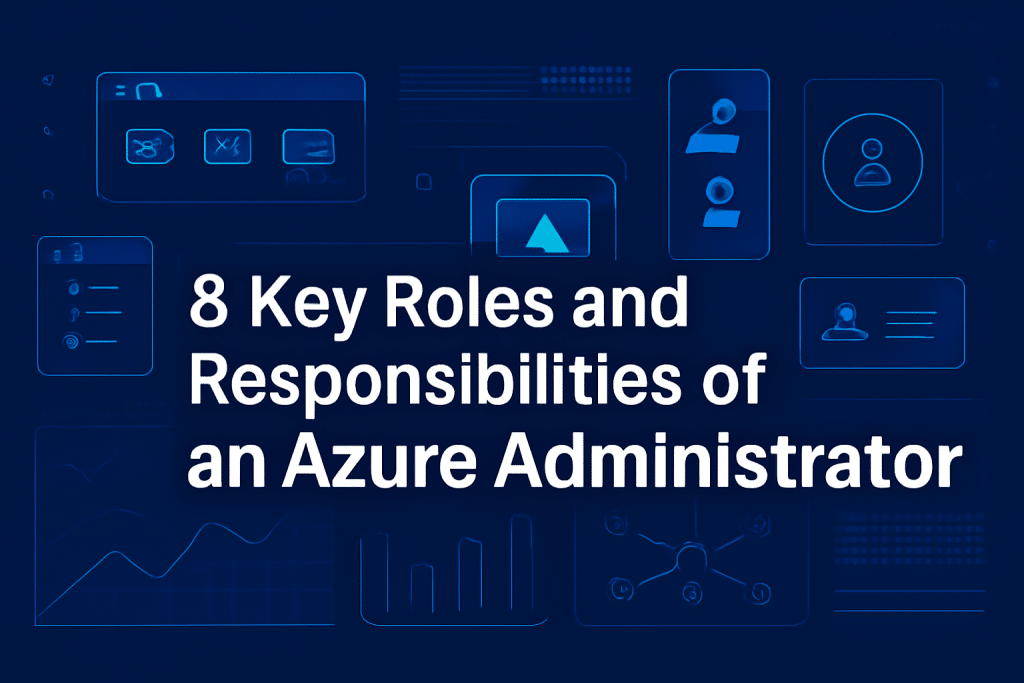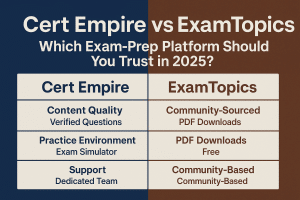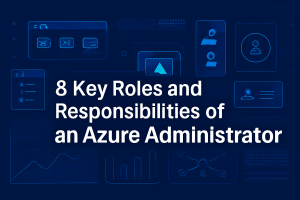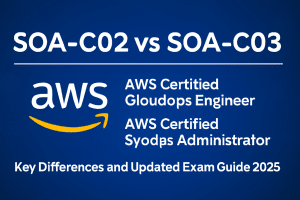TL;DR
- The Azure administrator manages and monitors all Azure resources to ensure optimal performance, availability, and cost efficiency.
- They configure virtual machines, virtual networks, and manage storage solutions with strong disaster-recovery planning.
- Azure administrators handle identity management, access controls, and security best practices to protect sensitive data.
- Key tools include Azure Portal, Azure CLI, Azure PowerShell, Azure Monitor, and Azure Security Center.
- The official certification is the Microsoft Certified: Azure Administrator Associate (AZ-104).
- Average salary in 2025 ranges between $82,000–$128,000, depending on experience and region.
- Top industries hiring include IT, banking, healthcare, and manufacturing.
- Cert Empire offers verified AZ-104 exam questions and simulators to help candidates prepare effectively and confidently.
Understanding the Azure Administrator’s Role in Modern Cloud Environments
In today’s cloud-driven world, the Azure Administrator plays a central role in maintaining business continuity, security, and operational stability within Microsoft Azure environments. These professionals act as the backbone of an organization’s cloud infrastructure, responsible for deploying, managing, and optimizing Azure resources.
With the exponential growth of Microsoft Azure, businesses now rely heavily on skilled Azure administrators to ensure that every cloud service, virtual network, and storage account performs efficiently. The Microsoft Azure Administrator Associate certification (AZ-104) has become a defining credential for professionals aspiring to validate their technical expertise in Azure administration.
In this guide, we’ll explore the eight key roles and responsibilities of an Azure administrator, the tools they use, and why this position remains one of the most in-demand roles in cloud computing.
Core Azure Administrator Roles and Responsibilities
1. Managing and Monitoring Azure Resources
The primary responsibility of every Azure administrator is to manage and maintain Azure resources across the organization. This includes provisioning new services, monitoring usage, and maintaining Azure subscriptions. They ensure that the company’s cloud resources are running efficiently while balancing costs and performance.
Administrators commonly work through the Azure Portal, Azure CLI, or Azure PowerShell to configure settings, adjust permissions, and deploy workloads. Their goal is to ensure all services run smoothly, meeting organizational requirements and compliance standards.
Monitoring involves tracking resource usage, reviewing performance insights, and utilizing Azure Monitor for alerting purposes. The ability to manage Azure resources directly impacts operational performance and system uptime—making this role a cornerstone of Azure administration.
Key tasks include:
- Configuring Azure subscriptions and resource groups
- Managing cloud resources using Azure Portal and Azure CLI
- Monitoring workloads for cost, performance, and efficiency
- Using Azure Monitor to detect and resolve issues
2. Configuring Virtual Machines and Virtual Networks
A significant part of the Azure administrator’s role is to manage virtual machines (VMs) and virtual networks (VNets) that power cloud environments. They deploy, monitor, and configure these resources to maintain business-critical applications and ensure seamless connectivity.
Virtual networking allows different components of Microsoft Azure solutions to communicate securely. Administrators manage network traffic, network security groups, and role-based access control (RBAC) to protect resources and ensure performance.
They also collaborate closely with other teams to maintain hybrid cloud environments, connecting on-premises infrastructure with Azure cloud systems.
Core duties in this role:
- Deploying and managing virtual machines
- Configuring virtual networks and subnets
- Managing network traffic and security controls
- Maintaining hybrid cloud integration and Azure networking
Their deep understanding of Azure architecture and network security ensures that the organization’s cloud environment remains stable and scalable.
3. Implementing and Managing Storage Solutions
The ability to implement storage solutions is one of the essential responsibilities of Azure administrators. They create and maintain storage accounts, manage data durability, and configure backup policies to prevent data loss.
Administrators are responsible for ensuring disaster recovery readiness. They design backup and replication strategies that safeguard business data in the event of system failures. Using Azure Resource Manager (ARM templates), they automate deployment processes and enforce consistency across environments.
These storage operations require a balance between cost efficiency and data security. By leveraging Azure Monitor, administrators can track performance, availability, and redundancy across Azure storage solutions.
Typical responsibilities include:
- Creating and managing storage accounts and disks
- Implementing backup and recovery strategies
- Using ARM templates for automated provisioning
- Ensuring data durability and compliance in Azure environments
In essence, Azure administrators guarantee that Microsoft Azure solutions maintain a resilient and cost-effective data foundation.
4. Managing Azure Identities and Access Controls
Maintaining secure access controls is crucial in protecting sensitive data across Azure environments. Azure administrators oversee identity management through Azure Active Directory (Azure AD), ensuring that the right users have access to the right resources at the right time.
They implement multi-factor authentication, role-based access control (RBAC), and least-privilege models to minimize risk exposure. These measures align with security best practices and support data security policies within the organization.
By integrating identity and access management (IAM) tools, administrators help mitigate unauthorized access and prevent insider threats. This responsibility not only protects infrastructure but also ensures compliance with global data protection regulations.
Key functions of this role:
- Managing Azure identities and user permissions
- Applying RBAC and multi-factor authentication
- Enforcing access management policies
- Protecting sensitive data using Azure Security Center
Strong access governance remains one of the most vital duties of every Microsoft Azure administrator—a direct reflection of an organization’s security posture.
5. Ensuring Security and Compliance in Azure Environments
Security remains at the core of every Azure administrator’s role. With organizations handling critical cloud resources, these professionals must deploy rigorous security measures to protect systems from threats and vulnerabilities.
They use tools such as Azure Security Center and Microsoft Defender for Cloud to continuously assess configurations and detect potential issues. Their work involves implementing security measures, auditing activity logs, and setting up network security groups (NSGs) to restrict unauthorized access.
Ensuring data security and maintaining compliance standards like ISO, GDPR, and SOC 2 requires careful planning and regular monitoring. Administrators play a hands-on role in enforcing security groups, access controls, and role-based permissions to keep every Azure environment resilient against attacks.
Responsibilities in this function include:
- Monitoring through Azure Security Center
- Applying security best practices for all Azure services
- Configuring network security and encryption policies
- Performing audits and maintaining compliance reports
In short, Azure administrators not only deploy and manage systems but also safeguard Azure environments from modern cloud threats.
Key Skills and Tools Every Azure Administrator Should Master
Becoming a successful Azure administrator requires more than just technical certifications—it demands a strong grasp of cloud operations, automation, and continuous optimization.
Key technical skills:
- Mastery of Azure Portal, Azure CLI, and Azure PowerShell
- Strong understanding of virtual networking, storage solutions, and Azure architecture
- Knowledge of role-based access control, network security, and disaster recovery
- Proficiency in Azure Monitor, Azure Resource Manager, and ARM templates
Soft skills are equally important. Administrators must demonstrate problem-solving ability, adaptability, and a solid understanding of emerging technologies. Their daily decisions directly impact the organization’s operational efficiency and data security.
The combination of technical skills and a proactive mindset enables Azure administrators to deliver reliable, scalable, and secure cloud environments.
6. Monitoring Performance and Resource Usage
One of the most consistent and crucial responsibilities of an Azure administrator is to monitor the performance of Azure resources and ensure that every service runs smoothly. This involves constant tracking of resource consumption, identifying underutilized assets, and improving operational efficiency across environments.
Administrators use Azure Monitor and Log Analytics to gain detailed insights into system behavior. These tools provide real-time metrics that help optimize workloads, improve cost allocation, and maintain performance stability. A well-structured monitoring process ensures that potential bottlenecks are addressed before they impact productivity or availability.
They also maintain dashboards that visualize resource usage, performance alerts, and trend reports to assist in capacity planning. The goal is to maintain balance — ensuring maximum performance while keeping Azure costs under control.
Core tasks in this responsibility include:
- Configuring Azure Monitor alerts for performance thresholds
- Reviewing resource usage reports for optimization opportunities
- Identifying services that require scaling or modification
- Ensuring operational efficiency through proactive maintenance
Azure administrators who master performance tracking build a reputation for reliability, ensuring that their organization’s cloud systems stay healthy and consistent over time.
7. Handling Backup and Disaster Recovery
Every experienced Microsoft Azure administrator understands the importance of data resilience. Implementing effective backup and disaster recovery strategies ensures that critical workloads remain accessible during outages or failures.
Using Azure Backup and Site Recovery, administrators design disaster recovery plans that replicate key workloads across regions. This guarantees business continuity and data durability, even in the face of unexpected disruptions.
A well-structured disaster recovery plan is essential for protecting both applications and data. It involves automating restore procedures, testing failover systems, and reviewing recovery time objectives (RTOs).
Common tasks in this domain include:
- Implementing backup policies using Azure Backup
- Replicating workloads across multiple regions
- Maintaining disaster recovery and data durability readiness
- Ensuring compliance with business continuity standards
By combining storage solutions, disaster recovery planning, and monitoring capabilities, Azure administrators ensure that the organization’s systems can recover rapidly from any data-related incident.
8. Supporting Automation and Infrastructure as Code
Automation has become a defining feature of modern cloud computing, and Azure administrators are often at the center of it. By leveraging ARM templates, Azure CLI, and scripting languages, they can automate repetitive deployment and configuration tasks to reduce manual overhead.
This approach, known as Infrastructure as Code (IaC), allows administrators to maintain consistent Azure environments while minimizing human error. Azure administrators use automation to streamline deployments, enforce policies, and manage Azure resources at scale.
For example, deploying multiple virtual networks or storage accounts manually is time-consuming. With ARM templates, administrators can deploy all configurations simultaneously with complete version control and rollback capabilities.
Key automation tasks include:
- Using ARM templates for resource deployment
- Writing automation scripts with Azure CLI or PowerShell
- Enforcing consistent infrastructure through IaC
- Reducing configuration drift across environments
Automation is the ultimate productivity multiplier for every Azure administrator. It enhances accuracy, improves speed, and supports scalable Azure solutions that evolve with organizational needs.
Key Skills and Tools Required for Azure Administration
To perform their roles effectively, Azure administrators rely on a mix of advanced technical skills and practical tools that help manage dynamic cloud environments.
Technical Skills:
- Deep understanding of Microsoft Azure architecture
- Proficiency with Azure Portal, Azure CLI, and PowerShell
- Expertise in virtual machines, virtual networks, and storage solutions
- Strong grasp of role-based access control (RBAC) and network security
Tools commonly used:
- Azure Monitor for performance tracking
- Azure Resource Manager (ARM) for deployments
- Azure Security Center for security oversight
- Azure Active Directory for identity and access management
In addition, Azure administrators need to stay informed about emerging technologies such as AI-powered security analytics, automation frameworks, and hybrid cloud technologies.
Azure Administrator Certification Path (AZ-104)
The Microsoft Certified: Azure Administrator Associate (AZ-104) is the official credential validating an individual’s expertise in Azure administration. It’s designed for professionals who manage cloud services including compute, storage, networking, and security within Microsoft Azure.
Exam Overview:
| Exam | Code | Format | Passing Score | Duration | Cost (USD) |
|---|---|---|---|---|---|
| Microsoft Azure Administrator | AZ-104 | Multiple-choice | 700/1000 | 120 minutes | $165 |
Key topics include:
- Managing Azure identities and governance
- Implementing storage solutions
- Configuring virtual networks
- Monitoring and backing up Azure resources
Candidates typically need at least six months of experience working with Azure cloud environments before attempting the AZ-104 exam.
Salary Outlook and Career Opportunities
The demand for skilled Microsoft Azure administrators continues to grow as more organizations migrate to cloud environments. Professionals with the Azure Administrator Associate certification are highly valued for their ability to manage Azure resources, maintain uptime, and ensure compliance.
Average Annual Salaries (2025):
| Job Role | Average Salary (USD) | Experience Level |
|---|---|---|
| Junior Azure Administrator | $82,000 | 1–2 years |
| Mid-Level Azure Administrator | $105,000 | 3–5 years |
| Senior Azure Administrator | $128,000 | 6+ years |
| Cloud Engineer (Azure Focused) | $118,000 | 4–6 years |
Beyond the numbers, the career advancement potential is strong. Many Azure administrators transition into roles like Cloud Architects, DevOps Engineers, or Cloud Security Specialists as they gain experience.
Industries Hiring Most:
- IT and Software Development
- Banking and Financial Services
- Healthcare
- Manufacturing
- Government and Education
With the rapid expansion of Microsoft Azure solutions, these roles will only grow in significance.
Why Organizations Depend on Azure Administrators
Enterprises rely on Azure administrators to maintain the integrity and performance of their cloud environments. They are essential for ensuring network security, maintaining storage solutions, and optimizing Azure resources across departments.
Administrators also play a proactive role in implementing security measures and ensuring compliance with internal and external policies. Their work supports seamless operation, safeguards critical sensitive data, and helps teams meet strategic business goals.
In short, an Azure administrator’s role connects every aspect of Microsoft Azure solutions—from resource management to disaster recovery, ensuring organizational agility and resilience in an evolving cloud computing landscape.
FAQs
1. What does an Azure Administrator do daily?
They manage Azure resources, maintain virtual machines, and ensure network security and uptime across cloud environments.
2. How difficult is the AZ-104 exam?
The AZ-104 certification exam is moderately difficult but manageable with the right training and practice exams. It requires practical experience with Azure services.
3. Is Azure Administrator a good career in 2025?
Yes. The Microsoft Azure Administrator role remains in high demand, offering strong salaries and opportunities for growth into cloud architecture and DevOps.
4. What tools do Azure Administrators use?
They rely on Azure Portal, Azure CLI, PowerShell, Azure Monitor, and Azure Security Center for management and automation.
5. How much can I earn after becoming Azure certified?
The average Azure administrator salary ranges from $82,000 to $128,000, depending on your experience and industry.
6. What is the best way to prepare for the AZ-104 exam?
Use official Microsoft resources, hands-on labs, and Cert Empire’s real exam questions to understand practical scenarios before taking the test.
Final Thoughts
The Azure administrator’s role is evolving quickly as cloud technologies become central to digital transformation. These professionals are vital in maintaining Azure solutions, enforcing security measures, and ensuring that every service runs smoothly within the organization’s cloud infrastructure.
For anyone looking to enter or grow in the cloud computing field, earning the Azure Administrator Associate certification (AZ-104) is a strategic step toward a future-proof career.
Cert Empire simplifies your journey by offering high-quality exam preparation resources, verified AZ-104 questions, and realistic practice simulators—helping you pass the exam and build confidence in your technical abilities.
Mastering the roles and responsibilities of an Azure administrator isn’t just about achieving certification; it’s about leading the next generation of cloud professionals capable of managing and securing the world’s most advanced Azure environments.
Last Updated on by Team CE



























